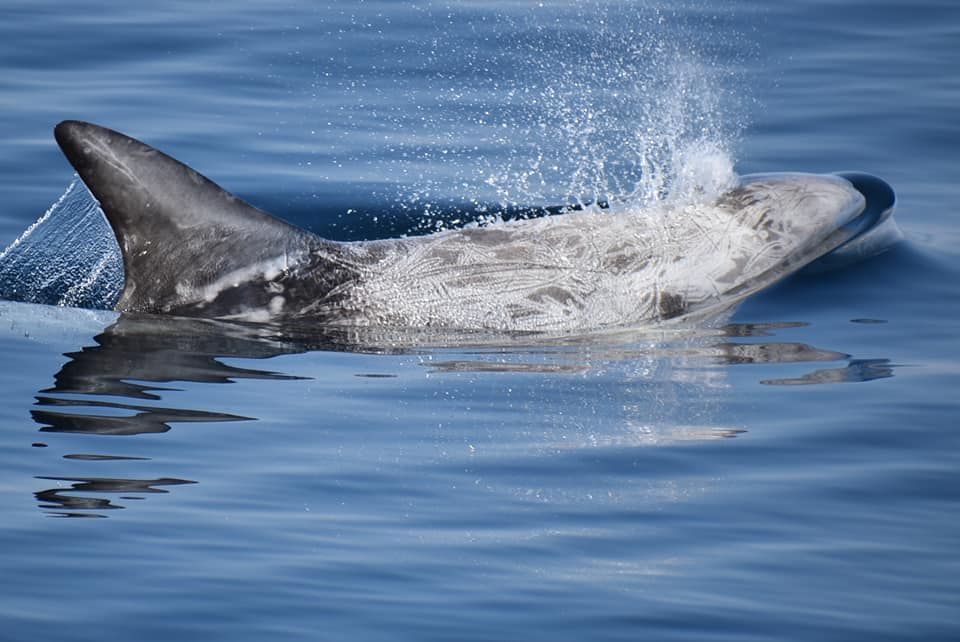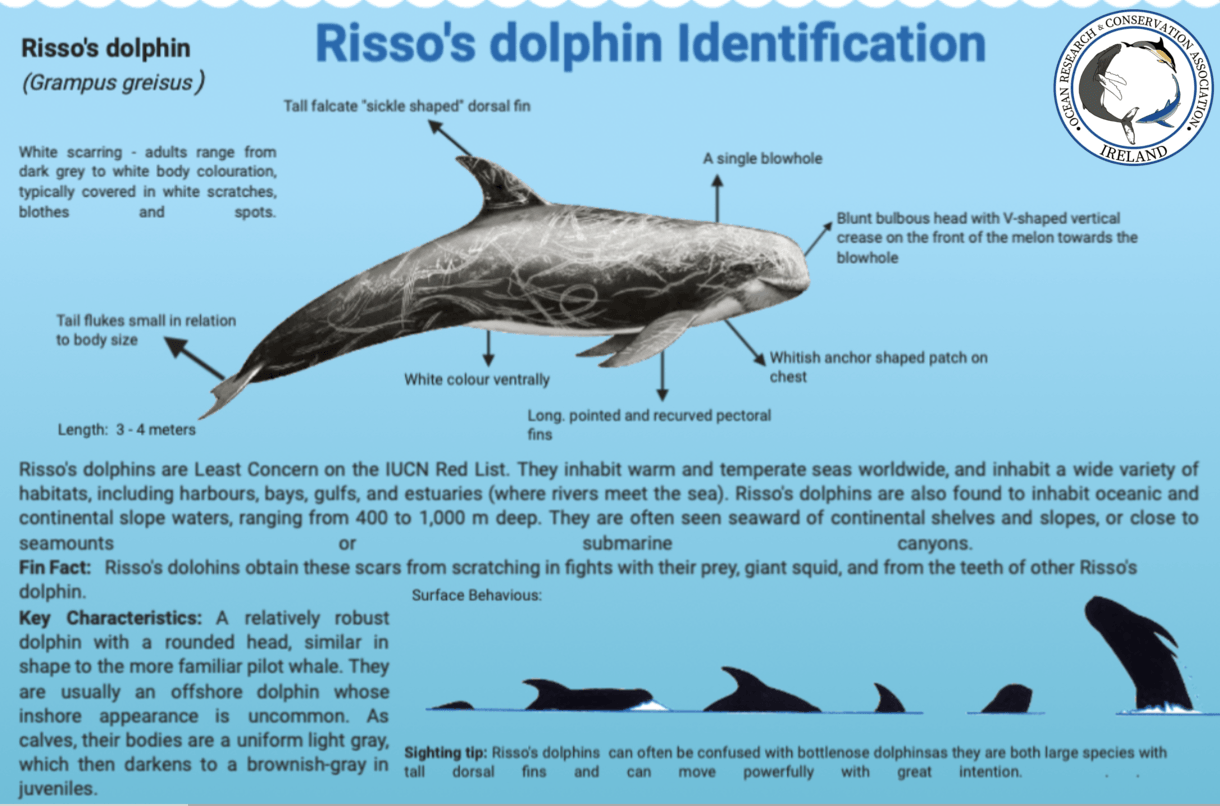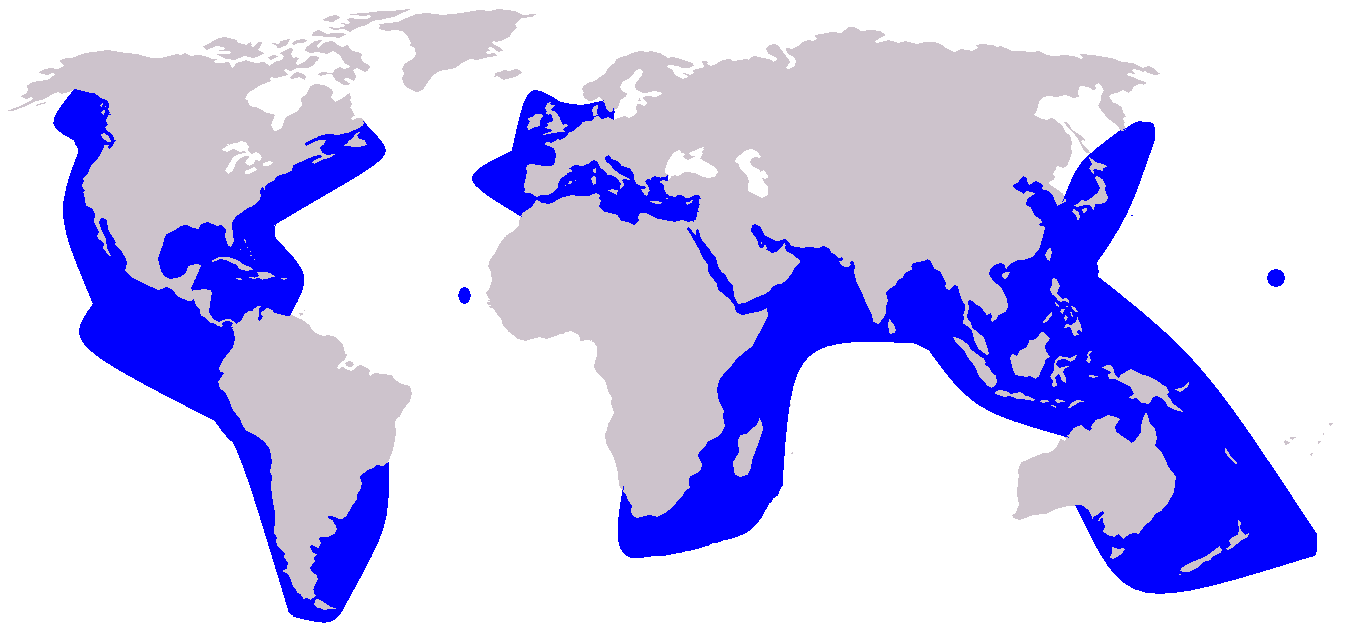Risso's Dolphin
(Grampus griseus)
Next Species ----->
<-----Previous species
Classification:
Kingdom: Animalia
Phylum: Chordata
Class: Mammalia
Order: Artiodactyla
Infraorder: Cetacea
Family: Delphinidae
Genus: Grampus
Species: G. griseus
Get the Facts:
The Risso’s dolphin (Grampus griseus) is the only species of dolphin in the genus Grampus. Another common name for Risso’s dolphin is the ‘Grampus’ (is which also the species genus). The specific name griseus refers to the mottled (almost scarred) grey colour of the dolphins body. They become scarred and battered which is caused by other Risso’s Dolphins teeth. Risso’s have teeth only in the front of their lower jaw which are used when playing or fighting.
Species Identification:
Risso's dolphins are generally easy to identify when observed at close range, particularly when they mature.; but, from a distance they may be confused with other large delphinids with a tall dorsal fin (such as bottlenose dolphins, false killer whales, and killer whales). When visible, the light, extensively scarred bodies and bulbous heads of Risso's dolphins make them unmistakable.
Risso's dolphins are robust cetaceans with blunt-heads with no distinct beaks, but with mouth-lines that curve upward. Their flippers are long, pointed, and recurved. The dorsal fin is tall and falcate. One of the most distinctive features is a vertical crease on the front of the melon. At sea, the best identification character is the white and grey coloration and scarring. Adults range from dark grey to nearly white, but are typically covered with white scratches, spots, and blotches. The chest has a whitish anchor-shaped patch, similar to the pilot whale, and the appendages tend to be darker than the rest of the body. Young animals range from light grey to dark brownish grey and are relatively unmarked Risso's typically reach a length of 3 meters although some have been recorded up to 3.8 meters. They can weigh between 300 - 500 kilograms. Males are larger than females.
Diet:
Risso’s dolphin diet consists of mainly cephalopods (especially squid, some octopus and cuttlefish), crustaceans and occasionally small fish. Generally they forage at night when their preferred prey migrate towards the surface, and sometimes forage cooperatively. They can dive for up to 30 minutes down to depths of 400-500 metres. Their soft-bodied prey is caught with teeth in the lower jaw and swallowed whole. They also get scars from feeding on cephaplopods which are visible on the skin surface.
Habitat:
Generally Risso's dolphins prefer deep offshore waters where their preferred prey squid are found. In Ireland, they can be seen near offshore islands, such as the Saltee Islands, Co. Wexford but can also be observed in coastal inshore waters along the east, south, north and west coasts.
Behaviour:
Risso’s Dolphins do not often ‘bow ride’ in front of boats like some other dolphins, and tend to avoid vessels or may swim beside or in the bubbly wake that a boat leaves. Risso’s dolphins are social, typically in groups of 10–30; but off California aggregations of several thousand have been observed. These groups spread out in a long line when hunting for food. During daytime, Risso’s dolphins move with speeds of 5–8 km/hr when traveling, normally showing part of the head with the blowhole, frontal back, dorsal fin, and back/peduncle area. Risso’s are often seen breaching, clearing the water and slapping their heads, tails or sides on the surface. During daytime, Risso’s dolphins regularly socialise, rest, or travel. Foraging mainly occurs during late afternoon and overnight. Some groups are shy, however, some allow humans to approach close to them. Young dolphins are very energetic and engage in breaching (leaping out of the water), spy hopping (lifting their head above the surface of the water to have a look around), slapping their flippers against the surface of the water and surfing on the waves.
Social Structure:
Risso’s Dolphins have a unique social structure described as a “stratified community.” Adults are grouped by age and sex classes. Males tend to cluster in highly stable social units, whereas females form stable nurseries during a summer calving season. Juveniles stay in the vicinity of their natal group for some years after being weaned and form bachelor pods of subadults at the
age of 6–8 . Stable associations between individuals over longer periods have been reported for populations in the Mediterranean and around Scotland. They are also often seen in the company of other whales and dolphins. Different temporal and spatial patterns between sexes appear and support the species’ complex social ecology, particularly the mating system. Nursing females occur closer to the coast than other social units, occupying a significantly smaller area.
Vocalisations:
When foraging they frequently produce a series of echolocation clicks; they also appear to combine acoustic features from different cetacean species such as beaked whales and bottlenose dolphins.
Reproduction:
Knowledge about the reproduction of this species is limited. Age at sexual maturity is thought to be 8–10 years for females and 10–12 years for males. Large testes (3% of the body mass) suggest sperm competition and a promiscuous mating system. Life history data described from bycaught animals suggest that gestation takes place over 13–14 months with a calving interval of 2.4 years. Long-term field data from the Azores indicate a calving interval of 4 years. A summer calving season is reported in South Africa and the North Atlantic. New born calves with accompanying females have been observed in other areas such as in the United Kingdom (Isle of Man, Scotland, Wales), Ireland, the Mediterranean, Chile, and Taiwan.
Population Status:
IUCN lists the species as “Data Deficient” on the European Red List. The species is classified as “least concern” globally in the IUCN Red List, but there are local population problems, especially recognised for European waters. There are no estimates of global abundance for the species, but Risso’s dolphins are considered abundant in most of their distribution area. On the European continental shelf, the abundance is estimated to be approximately 11,000 individuals, with highest densities off eastern Ireland and north-western Scotland.Urgent action on the conservation of Risso’s dolphins, particularly the establishment of protected areas and other appropriate measures for this species. This call is based on growing evidence for (i) the isolation of populations, in particular in the NE Atlantic, (ii) existence of critical habitat areas, including in the Azores and the United Kingdom, (iii) evidence for disturbance on the nursery grounds, (iv) the vulnerability of this species to human impacts, and (v) a general lack of information.
Global Distribution:
Risso’s dolphins are widely distributed in both hemispheres in tropical to temperate oceans. The species has a range that extends across ocean basins and spans between at least 64°N and 46°S, and is apparently absent from high‐latitude polar waters. Although Risso's dolphins occur in all habitats from coastal to oceanic, they show a strong range‐wide preference for mid‐temperate waters of the continental shelf and slope between 30° and 45° latitude.
Conservation Threats:
As with other squid eating marine animals, such as turtles and seabirds, Risso's dolphins risk swallowing plastic bags that they mistake for their prey. Once ingested, plastic may accumulate in the stomach of the animal causing starvation and lead to its death. It is likely that Risso’s dolphins commonly encounter plastic bags in the ocean and may be affected by this. Risso’s dolphins are also threatened by fisheries interactions and may suffer incidental capture in fishing nets which causes drowning. They may also be disturbed by noise produced by offshore oil and gas exploration, and similar to other cetacean species, are threatened by marine pollutants including organochlorines such as pesticides and industrial chemicals (PCBs).






